THE UN AS A DISPUTE SETTLEMENT SYSTEM: THE ROLE OF THE SECURITY COUNCIL
THE UN AS A DISPUTE SETTLEMENT SYSTEM: THE ROLE OF THE SECURITY COUNCIL
___
- Fromuth, Peter (1993). The Making of Security Community: The UN After the Cold War. Journal of International Affairs 46: 363-364. Gareth, Evans (1993). Cooperating for Peace: The Global Agenda For the 1990s and Beyond. Allen and Unwin. General Assembly in resolution 47/120 George, Scott (1973). The Rise and Fall of the League of Nations. London. Higgins, Rosalym (1972). The Advisory Opinion on Namibia. Which UN Resolutions are Binding under Article 25 of the Charter?, 21 ICLQ, 1972 Howard, Michael (1996). United Nations Divided World, The Historical Development of the UN’s Role in International Security. Clarendon Press. ICJ Reports, 1971 Lockerbie case, ICJ Reports, 1992. Peck, Connie (1998). Sustainable Peace: The Role of the UN and Regional Organizations in Preventing Conflict. Carnegie Corporation of New York Peck, Connie (1996). The United Nations as a Dispute Settlement System. Kluwer Law International. Report of the Secretary-General on the Work of the Organization, New York, 1993. Shaw, Malcolm (1997). International Law. Cambridge. Shaw, Malcolm (2017). International Law, Dispute Settlement trough the UN. Cambridge Security Council Resolution 509 (1882), with regard to Israel’s invasion of Lebanon Security Council Resolutions 234 (1967) and 338 (1973), the Middle East in 1967 and 1973 Sutterlin, J.S. (1995). Envisioning the UN in the Twenty-first Century, UNU Headquarters. The Report of Secretary-General on the Implementation of the Recommendation in the 1992 Report, A/47/965 Ury, Brett, and Goldberg, Brett (1988). Getting Disputes Resolved: Designing System to Cut the Costs of Conflict. Jossey-Bass. Urquhart, Brian (1986). The Role of the UN in Maintaining and Improving International Security https://www.tandfonline.com/doi/abs/10.1080/00396338608442322. Urquhart, Brian (1990). Role of the United Nations. http://www.mofa.go.jp/policy/other/ bluebook/1990/1990-2-4.htm. Urquhart, Brian (2004). Role of UN http://eng.globalaffairs.ru/number/n_3370 US Publication 2298 (1945). Wallensteen, Peter (1995). After the Cold War: Emerging Patterns of Armed Conflicts 1989-94. Journal of Peace Research 32: 333-350.
- ISSN: 2636-803X
- Yayın Aralığı: Yılda 2 Sayı
- Başlangıç: 2018
- Yayıncı: Aziz TUNCER
TANZİMAT SÜRECİNİN DÖNÜŞTÜRÜCÜ ETKİSİ VE MAHALLE MUHTARLIKLARININ KURULMASI
THE UN AS A DISPUTE SETTLEMENT SYSTEM: THE ROLE OF THE SECURITY COUNCIL
YEREL YÖNETİMLERİN KÖKENİ BAĞLAMINDA İTALYAN ŞEHİR DEVLETLERİNDE YÖNETİM VE AKTÖRLER
BİR ALMAN YÖNETİM YAKLAŞIMI OLARAK KAMERALİZM
TARİHSEL PERSPEKTİFTE REFAH DEVLETİ: DOĞUŞ, YÜKSELİŞ VE YENİDEN YAPILANMA SÜRECİ
